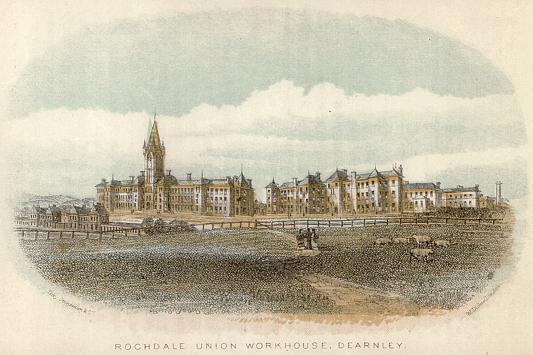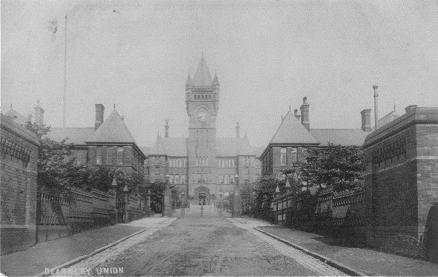The Dearnley or Birch Hill Workhouse

As early as 1598 the government decreed that parishes throughout England had to oversee their own poor and provide parish houses for those who could not support themselves and their families through work. Poor relief in the years following, further reinforced the responsibility of the parish through its townships for the poor by providing shelter and employment. However, this national arrangement became too expensive, costing £2 million pounds to the Exchequer in 1784 but £7 million pounds by 1832. Something had to change and the New Poor Law of 1834 shifted onus and responsibility by recommending that those unable to survive through employment should go to the workhouse and do menial work there, the place being administered by local workhouse unions. Although shelter, basic food and employment would be found in the workhouse, they became unpopular as conditions in them was far from pleasant. However, by 1850 most towns in Britain had workhouses.
Rochdale was no exception, its Poor Law Union forming in 1837 in the face of much delaying opposition from local ratepayers led by Alderman Thomas Livsey who called for a boycott of the election of workhouse Guardians on the grounds that workhouses were becoming ‘prisons for the poor’ and where inmates were divided by age and gender. Delaying tactics worked only temporarily however, so the protesters decided to put up their own candidates for Guardians who, once elected would refuse to attend crucial Board meetings. The fight continued as people in the town were fiercely opposed to the Poor Law Amendment Act, Rochdale’s first MP, John Fenton, losing his seat after he voted in favour of the law. However, after many legal threats and further delays the Poor Law Union Act was implemented in the town and workhouses for some time afterwards catered (through periods of boom and bust in the textile industries) for many hundreds of people so that by the mid 19th century under the Poor Law, Rochdale had workhouses in Spotland on Primrose Street (100 places), Marland off Marland Old Road (50, later 300) Hollingworth on Syke Lane (58), Calf Hey near Wardle Fold (30) and at Wardleworth (24).

Over the years and due to gradual overcrowding and very poor conditions in the workhouses, the local Poor Law Guardians looked to find an alternative to the Spotland, Hollingworth and Wardleworth workhouses. The one at Spotland in particular was in such a parlous state structurally that part of it collapsed possibly due to coal mine subsidence under its foundations. Even though it was patched up temporarily it stayed open for a number of years during the late 1860’s, ‘lunatics and imbeciles’ according to Spotland Township minutes, ‘being kept in that part of the building which had given way.’ Furthermore, the Spotland workhouse had been recently inspected and found wanting in a number of other ways, being primarily criticised for :
two men sharing a bed at the workhouse (a common criticism),
the lack of proper workhouse dress being provided, inmates wearing their own clothes, allowing smoking in both the men’s and the women’s sections (another common complaint), inadequate judgement as to the prevalence of infectious disease,
the use of the cellar as a mortuary
the administering of medicines by illiterate pauper inmates
So in 1871, in the face of overcrowding in the workhouses of the town, the Rochdale Poor Law Union proposed the building a giant workhouse and to that end bought 24 acres of land on the slopes of Birch Hill and Starring Hill for £2500. The Dearnley or Birch Hill workhouse at the end of Union Road, complete with tower and clock face that can be seen from miles around was designed by George Woodhouse and Edward Potts to accommodate 632 of the poor although, at its capacity, it held 847 alongside 29 ‘officers.’ Served by a tramway on Halifax Road it eventually opened its doors to the poor in December of 1877, the full cost of the building being £85,000. The opening ceremony was led by the Mayor of Rochdale, Alderman T Schofield, preceded by a tour of the workhouse for the seventy guests, speeches by dignitaries and a performance by the Orpheus Glee Club. By the turn of the 20th century the building was extended to incorporate a 172-bed infirmary and a central healthcare administration block.
Following its use as a workhouse, the Birch Hill buildings were used as a military hospital in the Great War with tents erected in the grounds and from 1930 the site was passed to Rochdale County Borough with the Poor Law Institution being run by the Public Assistance Committee and the Hospital being run by the Health Committee. In 1948 Birch Hill became an important part of the National Health Service’s provision for the town until its closure in 2013. Whilst most recently buildings on the site form part of Birch Hill Clock Tower apartments, one wonders whether those living there are aware of the suffering and succour that has taken place on that hill.